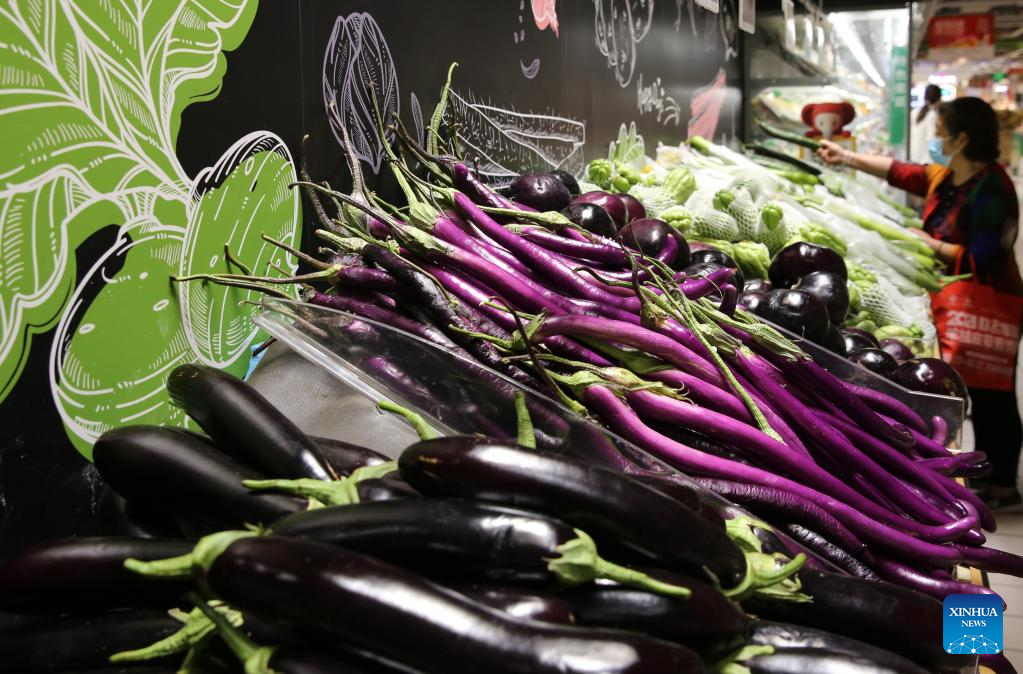Economic Watch: China's consumer prices see mild uptick, factory inflation narrows

Customers buy vegetables at a supermarket in Mengzi, southwest China's Yunnan Province, May 11, 2022. China's consumer price index (CPI), a main gauge of inflation, rose 2.1 percent year on year in April, the National Bureau of Statistics (NBS) said Wednesday. (Photo by Xue Yingying/Xinhua)
BEIJING, May 11 (Xinhua) -- China's inflation has remained at an overall moderate and controllable level, with consumer prices seeing a mild uptick in April and factory prices facing cost pressure, official data showed on Wednesday.
The consumer price index (CPI), the main gauge of inflation, rose 2.1 percent year on year in April, and went up 0.4 percent from the previous month, according to the National Bureau of Statistics (NBS).
The rise were partly due to the domestic resurgence of COVID-19 and the continuous rise of bulk commodity prices across the globe, noted Dong Lijuan, a senior statistician with the NBS.
Food prices went up 0.9 percent from the previous month, driving up the monthly consumer inflation by about 0.17 percentage points.
Specifically, the price of pork, a staple meat in China, increased 1.5 percent month-on-month in April, compared with a 9.3 percent decrease in March. Hog production has gradually tempered and stockpiling of pork to replenish state reserves is in progress, Dong said.
Pork prices still registered a year-on-year drop of 33.3 percent, narrowing by 8.1 percentage points from the previous month.
Non-food prices rose 2.2 percent from a year earlier, the same growth recorded the previous month. The prices of gasoline, diesel and liquified petroleum gas went up by 29 percent, 31.7 percent and 26.9 percent year on year, respectively.
The core CPI, which excludes food and energy prices, gained 0.9 percent year on year in April, down 0.2 percentage points from the previous month.
Wednesday's data also showed that China's producer price index (PPI), which measures costs for goods at the factory gate, went up 8 percent year on year in April.
The figure moderated from the 8.3 percent year-on-year increase registered in March this year. On a monthly basis, China's PPI gained 0.6 percent in April, compared with the 1.1 percent increase seen in March.
"China's inflation has remained at an overall moderate and controllable level," commented Wen Bin, chief analyst at China Minsheng Bank.
Although both the monthly and year-on-year PPI growth rates slowed, "price hikes in bulk commodities across the globe still impose imported inflationary pressure on PPI," Wen said.
UNCERTAINTIES, POLICY RESPONSE
Experts attributed the current high inflationary pressure in the global market to Western countries' disorderly domestic governance and tendency to stir up trouble and bully other countries, per a recent symposium held by the National Development and Reform Commission.
Major economies in the West have been issuing excess paper currency and implementing loose monetary policies since the pandemic, which has pushed up bulk commodity prices, according to the symposium.
Experts also noted that supply chain disruptions caused by COVID-19 and some Western countries' recent sanctions on Russia have further choked the global bulk commodity supply.
On the domestic front, a report released on Monday by the People's Bank of China said that shrinking demand, supply shocks and weakened expectations brought about by the recent domestic resurgence of COVID-19 continue to linger, with contact-based consumption such as catering and retail posting a sluggish performance.
The central bank reaffirmed its intention of implementing prudent monetary policy this year in the report, saying that it will avoid "flood-like" stimulus and better utilize monetary policy tools to adjust both the monetary aggregate and the monetary structure.
Supporting the real economy and small and micro businesses, and boosting technological innovation, elderly care services and the clean use of coal while defusing risks faced by financial institutions remain the policy priorities, the report said.
In general, China's economy has been maintained in a reasonable range, with a sufficient supply of industrial and agricultural products, resuming consumption and investment demand and prudent monetary policies, which is conducive to keeping prices stable in the medium-to-long term, according to the report.

A customer buys vegetables at a supermarket in Linquan County, east China's Anhui Province, May 11, 2022. China's consumer price index (CPI), a main gauge of inflation, rose 2.1 percent year on year in April, the National Bureau of Statistics (NBS) said Wednesday. (Photo by Lu Qijian/Xinhua)

A customer buys fruits at a supermarket in Chengbu Miao Autonomous County, central China's Hunan Province, May 11, 2022. China's consumer price index (CPI), a main gauge of inflation, rose 2.1 percent year on year in April, the National Bureau of Statistics (NBS) said Wednesday. (Photo by Yan Qinlong/Xinhua)

A customer buys vegetables at a supermarket in Wuxi, east China's Jiangsu Province, May 11, 2022. China's consumer price index (CPI), a main gauge of inflation, rose 2.1 percent year on year in April, the National Bureau of Statistics (NBS) said Wednesday. (Photo by Huan Yueliang/Xinhua)


